“How Can You Talk About The Wage?”: First Testimony about 1st January Dam Construction Site
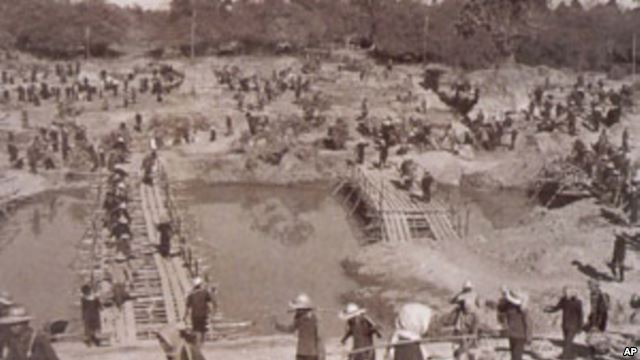
1st January Dam, Chinith River, Kampong Thom province, 1976. (Picture via VOA Cambodia here)
Background
Today, the Trial Chamber of the ECCC continued its hearing of witness testimony in Case 002/02 with the first testimony about the 1st January Dam worksite.
The 1st January Dam is one of the six worksites set out in the Closing Order of Case 002/02, where crimes against humanity, as defined in Article 5 of the ECCC law, were allegedly committed by the defendants, Nuon Chea and Khieu Samphan.
Specifically, the Closing Order alleges that the defendants are responsible for:
- inhumane acts through attacks against human dignity
- enslavement
- extermination
- murder
- other inhumane acts through enforced disappearances
- other inhumane acts through forced marriage
- persecution on political grounds
- persecution on religious grounds
Paragraph 358 of the Closing Order alleges that “tens of thousands of people participated in the construction of the 1st January Dam.” It states that “everyone, workers and cadres, lived in a constant state of fear of being arrested and taken away to be killed.” [Id. at paragraph 362.]
It is also alleged that workers at the construction site “could not speak or move freely. Whistles or loud speakers were used to gather the workers, who worked according to set times without rest or with strictly controlled periods of rest. Most teams worked night shifts. There was a fixed quota of soil to dig and carry per day and those who could not meet the quota were punished.” [Id. at paragraph 369.]
[NB: The closing order quoted above carries a prominent disclaimer: “The content in Closing Orders are allegations, which need to be proven through adversarial hearings. As such, the allegations . . . can not be treated as facts unless they have been established through a final judgment.” Such adversarial proceedings are ongoing now and the substance of these reports. These allegations are unproved facts given as background. When disputed by defense counsel, it is noted.]
Biography of Witness Or Ho
Or Ho, aged 70, was called to the stand. Born October 5, 1945, Mr. Or is a rice farmer. He currently resides in Toul Sley Village, Kampong Thom province. His father was Or Keit and his Mother, Morm Oum. His wife’s name is Som Reth. They had nine children together but four have passed away.
Or Ho worked as a Khmer Rouge cadre from 1972 until 1978, although the Khmer Rouge had occupied his area since 1970.In 1972, he was appointed the deputy chief of Prei Snhea village, Balangk Commune, Baray District, Sector 42. In 1975, he was promoted to chief of the village, a position he held until removed by Angkar in 1978.
Mr. Or was not a party member but was a “call person” for the party. He defined a “call person,” as “a progressive person who would achieve the goals of the party and make people work.”
The witness worked on constructing The 1st January Dam and helped build its irrigation canals. His village was only three kilometers away from the dam.
“17th April People“
Under the examination of Seng Leang, Deputy Prosecutor, Mr. Or explained who the “new people” were and how they had arrived at his village.
When Phnom Penh fell to the Khmer Rouge on April 17, 1975, people were sent away and “deposited” in the provinces.
These people were called variously: “17th April people,” “new people” or “depositee people” because they were new to the places to which they were sent. They were also “new comers” to the revolution in contrast to the “base” people who had joined the Khmer Rouge before 1975.
The “new people” group arrived at Or Ho’s village in late April, 1975. He does not recall exactly when. There 300 families and his commune received 100 families.
As chief, Mr. Or was called into a meeting at the commune where he received instructions that the population had to be divided into three groups: “full rights people,” “candidate people” and “depositee people.”
In testimony given under International Co-Prosecutor Nicholas Koumjian, Or Ho spelled out how people were divided among the three groups.
Usually “full rights people” were the very poor, who could only earn a living on a day-to-day basis.
People who were a bit wealthier were considered “candidate people,” a middle-ranked classification.
Those who were even better off, an upper class, were placed in the lowest group as “depositee people”. All of the “new comers” from Phnom Penh, the “17th April people,” were put in the “depositee people” group.
Mr. Or did not know why there were three groups as they all did the same work in the fields.
In his village (Mr. Or did know about other villages), all three groups received the same treatment. There was no difference in food rations between “base people” and “new people” and they ate collectively. Every group would receive the same amount of gruel: “If one group received two ladles of gruel, the other group would receive two ladles of gruel,” the witness said. Oh Ho maintained that no one in his village died from starvation because they all received the same food ration which was supplemented by fish they could catch in a nearby stream after they returned from work.
Reprimands
Mr. Or reported that “base people” and “new people” also received the same disciplinary treatment and were reprimanded the same way when they committed minor offenses. Mr. Seng read in from the witness’s statement given to the Office for the Co-Investigating Judges (OCIJ) in 2008, (English: 00250047), that some people were prosecuted more often. Or Ho made plain that when “new people” committed serious faults, the village chief was not the one who reprimanded them, and the chief could not then guarantee their safety. “Depositee people” were found to be more often at fault, because ‘depositee people’ would tell their secrets to their friends.”
Treatment of former Lon Nol officials
When cadres identified former officers of Lon Nol, Mr. Or related, “we felt pity for them because the security officers would come to arrest them. They were arrested and put in a security office.”
Mr. Or went on to explain that “17 April people’” were killed because of information they themselves had divulged to the authorities. Further, Democratic Kampuchea used informants to find out which people had worked for the previous regime:
The Khmer Rouge gave a set of black clothing and a bicycle to a youth named Kao. He was a former teacher: a “17th April person.” This person was indoctrinated so he could go and search for former officials or civil servants of Lon Nol.
Mr. Or remembered that guards also went around and asked people to tell the truth about whether the people were former soldiers. In particular, they would be search for anyone who had graduated from Grade 12. “If by mistake they said those words,” they were reported to “the upper echelon. They could not be saved, they had to die.”
Seven Families Who Were Disappeared
Mr. Or recalled that on one occasion he was a given a list of 15 families, selected by “the upper level,” to be taken away to another village. “But this other village was a killing site,” the witness had concluded “because neighbors never saw those people being returned.”
Or Ho was able to conceal eight of the families. He was able to do this, not because they were special, but “because they were not talkative and they did not go around speaking to anyone.” The other seven families were sent away. The age of the victims varied. Some were elderly; some were children.
After the seven families had been sent away, new clothing was brought to his village. Some of the clothes were recognized to be the clothes that members of the seven families had been wearing when they were taken away. Mr. Or never saw those families again and he believes they were killed.
Cham People
The Cham People “are an ethnic minority within Cambodia who share a common language, a common culture, and Islam as a common religion.” [Id. at 745]
During the Khmer Rouge regime, under the Communist Party of Kampuchea (CPK), the Cham were prohibited from practicing their religion. The Closing Order (paragraphs 211 and 212), alleges that “[t]he CPK imprisoned or killed Cham religious leaders and elders and Cham people who protested or continued to practice their religion. The CPK also prohibited the Cham culture, language and dress. . . . Mass executions of Cham occurred in 1977 and 1978.”
Mr. Or, in his testimony added that: “The ethnic Cham were considered even lower than the “17th April people.” They were forced to eat ham and were not allowed to worship. “
He described that the Cham people were treated very strictly in his village and they were not allowed to use the mosque.
When Mr. Or was asked if was aware of policies to exterminate the Cham people, he said:
“I only know they wanted only ethnic Khmer. I do not have the concrete source. But I knew they only wanted ethnic Khmer but they failed to achieve that.”
1st January Dam
“The Bloody Dam” video on the January 1st Dam by the The Deutsche Gesellschaft für Internationale Zusammenarbeit using DC-Cam stats.
Background
The 1st January Dam is located in the southern part of the Balangk Commune. It holds back the Stoeung Chinit River. Some 5 or 6 kilometers away, it connects with the 6th January Dam. It gets its name from its inauguration date of January 1, 1977. According to Mr. Ho, the inauguration was cheered by Pol Pot. When pressed whether the Zone Chief Ke Pork had pointed Pol Pot out to him at the ceremony, Mr Ho said that: “the high ranking officers were not spoken of by name but we were told that Angkar had come to the inauguration.”
Mr. Or testified that Zone Chief Ke Pork was supervisor of the overall construction project: “He was assigned by ‘the upper echelon’ to be in charge and would visit the worksite on a daily basis.”
In dry season, Or Ho helped dig the water canals for irrigation. In the rainy season, he was asked to help on the dam where he supervised 100 workers. Mr. Ho confirmed that there were around 20,000 workers in total at the site, and that they had come from sectors 41, 42 and 43.
Working Conditions
Or Ho explained that they worked 13-hour work days for ten straight days, with only the eleventh day off. The work day started at 4:00 a.m. and continued until 11:00 a.m. when they stopped for gruel. They picked up at 2:00 p.m. and stopped again for gruel at 5:00 p.m. They then worked from 7:00 p.m. and until 10:00 p.m.
When asked whether this work was voluntary or forced, Mr. Or smiled and said: “It is difficult to say, either if it was voluntary or it was forced. Whatever the conditions, we had to work there.”
When asked whether they were given any compensation or pay for their work, the witness again smiled and said:
“How can you talk about the wage? The only thing we wanted was enough gruel to eat.”
Co-Prosecutor Koumjian observed that Mr. Or had smiled at the last two questions. He asked whether this was because Mr. Or was told that if he did not do what he was told something very bad would happen. The witness smiled again and agreed: “Yes. That is correct.”
Eating at the worksite was done communally and in units. Husband and wives would not be allowed to eat together unless they were working on the same site. Two ladles of gruel were given to each worker. When occasionally the meal was cooked rice, the same amount would be distributed.
The work was “extremely difficult,” Mr. Or said. “When the weather was hotter, it meant we had to work harder because there was no rain. Our skin was exposed directly to the sunlight. The gruel was merely enough. ”
Quotas and “Enemies”
Mr. Or testified that there were quotas (of either two or four cubic meters of earth) instituted for the amount of dirt each person had to carry manually each day.
“On some days,” Mr. Or reported, “we could achieve one cubic meter, other days we could achieve two cubic meters of dirt. If we did not achieve the quota, and the superiors noticed, there would be problems. If the village chief (understanding the conditions) said nothing, then the work just kept on going.”
Victor Koppe, Nuon Chea Defense Counsel, objected to Mr. Koumjian’s querying the witness if he feared serious consequences if the work was not done: “The witness cannot be asked to speculate as to what could have happened.”
The objection was overruled but Mr. Koumjian rephrased asking: “Is it true that when work didn’t go to plan, ‘upper level’ would accuse ‘lower level’ of being enemies and kill them?”
Mr. Or:
“During the construction, ‘middle level’ designated the plans for the ‘lower level’ to do. “Upper level” approved. When ‘upper level’ found work had not been done, ‘upper level’ killed ‘lower level;’ sometimes ‘middle level’ also killed ‘lower level.’”
Mr. Koumjian kept pushing to determine what it would take to be labeled as an enemy: “Was not carrying enough dirt enough to become an enemy? Was not fulfilling the quota enough?”
Mr. Or Ho submitted that “those people were considered the infiltrated enemies and were considered to be obstructing the work.”
Later in his testimony, the witness stated that, at the commune meetings, there was talk about seeking out enemies: “They said that enemies had to be removed. They said that the worms need to be removed one by one.”
Mr. Or did not know who carried out the executions. He was firm that those arrested were sent to the security office at the Wat Baray Choan Dek Pagoda and did not return to the worksite.
Forced Marriages
The prosecutor moved on to the subject of forced marriages.
Marriages in Or Ho’s district were prohibited from 1975 to 1977. The witness outlined that this was due to the war not being over yet and Angkar needed men and women to fight the war.
“Starting in September, 1977, they did allow marriages, said Mr. Or, “so that no single women would remain. I arranged marriages for them. Sometimes 30 to 40 couples were married at the same time. “
Victor Koppe objected on the grounds that this line of questioning was not relevant to the substance of the issue at hand, the 1st January Dam. The prosecutor retorted that the Chamber has been very clear that the witnesses may be questioned on all parts of the case of which he or she has knowledge. The President of the
Court, Judge Nil Nonn, overruled Mr. Koppe, enabling the prosecutor to continue.
As the actual parents were neither informed of the marriage nor allowed to attend the wedding nuptials, the commune stood in as parent. The marriages had to be approved by “the upper echelon:”
“In my village, the man would tell that he loved a certain woman and the woman would do the same. And after that we would make a report through the ‘upper echelon.’ The ‘upper echelon’ would receive the biography and then we would arrange the marriages.”
Hong Kim Suon, Civil Party Co-Lawyer, asked what would happen if anyone disagreed with the marriage. Or Ho acknowledged that some people did not agree to get married. “For those that refused marriage,” he said, “nothing happened to them. Punishment was not imposed on them. When they refused nothing happened.”
Concerning the logistics of the ceremony, Mr. Ho opined it was not much of one:
“Concerning dishes food and traditional music, there was no such thing. We were only allowed to have meals in the dining hall. The couple would sit close to each other. And after that Angkar would introduce them to each other and would ask a resolution from the couples. It lasted about three hours. There were no special meals. [Afterwards], if their parents were alive, they would go to their parents’ house [to consummate the marriage]. If not, the village chief would find a house for them to spend time together.”
After clarification questions from Judge Fenz and Judge Lavergne, the court adjourned. The Chamber will continue to hear Or Ho’s testimony tomorrow.

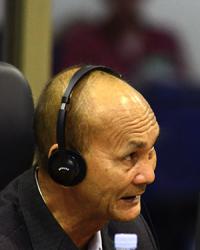
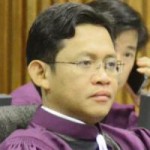
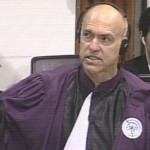
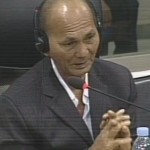
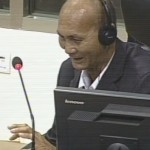
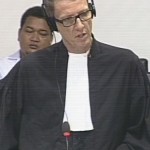
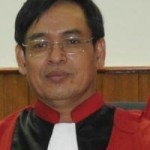
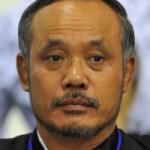
[…] wit, as was detailed when this Chamber started hearing testimony about it, the 1st January Dam is one of the six […]
[…] the trial –you can read about this worksite and the alleged crimes that were committed there here — to listen to this witness, which was the last one reaming from that segment of the […]
[…] Guisse cites the testimony of Mr. Ar Ho (which you can read about here), whom she characterizes as another unit chief, that had said that he had allowed his workers to […]